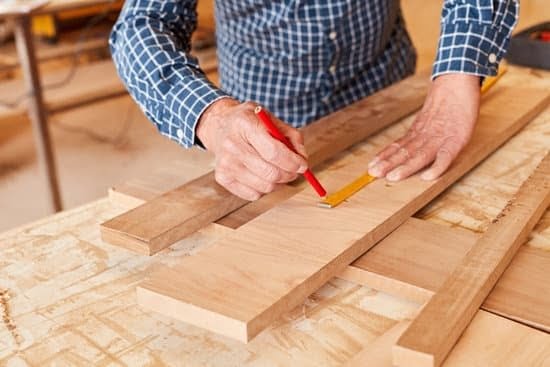Introduction
Green woodworking is a skill that has been passed down through centuries, originating in Europe and later popularized in North America during the 18th century. It is a method of working with freshly cut, unseasoned wood to create furniture, tools, and other wooden items. Green woodworking requires basic tools such as saws and planes but also relies heavily on human strength to transform the raw material into something completely unique.
The practice of green woodworking offers many benefits for today’s green-conscious society. One benefit is that it produces fewer emissions due to the lack of energy needed for conventional woodworking methods. As well, green woodworking results in minimal waste since little excess is required when working with freshly sawn timber. This type of traditional craftsmanship can give people more control over their environment by making them more self-sufficient and allowing them to create beautiful pieces knowing they are made from sustainable resources.
In addition to its environmental advantages, green woodworking offers several creative opportunities. Workers have the chance to use their imagination and ingenuity while creating items that are both functional and aesthetically pleasing. With an eye for detail and careful planning, any amateur or professional can take advantage of this ancient tradition and produce one-of-a-kind works with unique character through sophisticated techniques like steaming or carving which adds texture or specific shapes to the finished product. Thanks to its long history and recent reemergence in popularity, there are plenty of resources available online with tips, tutorials and videos on how to get started with this interesting craft!
Understanding the Basics of Green Woodworking
Green woodworking is a type of creative craftsmanship and carpentry that focuses on using sustainable materials that are better for the environment. This type of woodworking requires an understanding of both traditional methods as well as eco-friendly alternatives, such as utilizing upcycled materials and relying on more sustainable sources for building material. Some basic green woodworking ideas include repurposing old pieces into something new and interesting, creating beautiful items from tree limbs, or experimenting with different styles of wood crafts such as carving. Additionally, many people choose to use natural finishes in order to create a unique look without using harsh chemicals. There are also many ways to reuse scraps of wood from construction sites or lumberyards, in order to reduce the amount of trees that need to be cut down for new projects. Green woodworkers may also consider using tools such as non-electric saws or adzes for carving in order to reduce their environmental impact further. By understanding the basics of green woodworking, one can create beautiful items while still reducing their effect on the planet.
How to Choose the Right Eco-Friendly Wood for Your Project
When it comes to green woodworking, the first step is to choose the right type of wood. There are a variety of eco-friendly options out there, and it’s important to do your research before beginning a project. Consider each species on its own merits when deciding which one is best for you.
When selecting an eco-friendly wood, consider sustainability practices such as those employed by Forest Stewardship Council (FSC) certified organizations. These organizations strive to minimize harm to forests while ensuring the safety and preservation of their resources. They also use methods that prevent overharvesting and exploitation, so you know that you’re buying materials from a responsible source. Additionally, look for woods that come from renewable sources or fast-growing trees; using these materials can help reduce strain on natural supplies. Additionally, bamboo or cork offer viable eco-friendly alternatives for flooring or other projects ” just make sure they are sustainably sourced too!
Finally, pay attention to the chemicals used in treating and finishing the wood. Unsustainable paints and stains often contain harmful toxins that can be released into the environment once applied; opt for low-VOC (volatile organic compounds) water-based finishes instead to keep your project’s footprint as small as possible. And if you’re making something like furniture, try looking for pieces that have already been made with environmentally friendly techniques so there’s no further impact on the environment!
Finding Sustainable Wood Sources
Finding sources for sustainable wood is essential for green woodworking. Green or sustainable woods are sourced from forests that are sustainably managed, meaning they are managed in a way that the resources remain abundant in the future and are not put at risk due to unsustainable practices. There are different ways to source sustainable wood, including by sourcing certified wood such as FSC-certified wood (Forest Stewardship Council), which guarantees that the wood comes from responsibly managed forests with high standards when it comes to conservation and social responsibility. Another way to find sustainable lumber is to visit local sawmills or forest products stores, as these stores might sell locally sourced timber or rejected lumber from large mills, which help save on environmental transport costs. You can also purchase used/salvaged lumber from architectural salvage yards as an alternative to new lumber. Reusing materials significantly helps reduce deforestation and is beneficial for both people and the planet.
Assessing the Environmental Impact of Your Woodworking
When considering green woodworking ideas, it is important to assess the environmental impact of your woodworking projects. Sustainable woodworking places an emphasis on resource conservation and environmental responsibility. This concept encourages woodworkers to recognize that building a piece of furniture or a craft project is more than just creating something out of wood; it also involves finding smart ways to use materials in efficient ways and reduce the overall waste generated from their work.
Assessing the environmental impact of your projects can involve a few steps. Prioritize sustainably-sourced lumber and reuse any salvaged or reclaimed materials you may come across while completing a project. Recycle any offcuts and sawdust when possible too, either by donating them to local schools for classes or workshops that require sawdust, or contributing them to mulch pile at a local park designed for composting garden material. Utilizing these sustainable practices can reduce your carbon footprint in the long run!
Popular Green Woodworking Projects
Green woodworking projects are becoming increasingly popular, as more and more people are looking for ways to be environmentally conscious while still being creative. From creating furniture out of salvaged wood to designing wooden kitchenware with a low environmental impact, these types of projects give an opportunity to create something both functional and stylish that won’t cost the earth. Some popular green woodworking projects can include making live edged tables and chairs, which take advantage of materials that may have otherwise been wasted; creating a herb planter from fallen branches; crafting beautiful boards from recycled wood scraps; constructing birdhouses out of scrap lumber; building compost bins out of recycled pallets; or using old window frames to build shelves or wine racks. Green woodworking projects are not only great for the environment though, they can also make fantastic one-of-a-kind pieces that will look unique and beautiful in any home.
Tips for Using Eco-Friendly Tools & Practices
Green woodworking ideas can help reduce the environmental impact of traditional woodworking practices. To create eco-friendly projects, use recycled materials, including salvaged or reclaimed lumber, and operate natural-energy powered tools. Reuse planks for projects like furniture, boxes and shelves. Choose locally sourced producing timber that is managed responsibly. Allow woods to reach natural drying temperatures prior to use by circulating air around them for a few weeks if possible. Most importantly, take proper safety measures when using any tool from grinding discs to saw blades. Wear protective clothing such as gloves and goggles and a dust mask during the sanding process. Consider removing paint with chemical strippers instead of sanding ” it can be safer and more effective while reducing dust in the workspace. When joining pieces of wood together use handicrafting methods such as dovetailing or mortise and tenon jointing instead of glue which can contain hazardous solvents. Make sure to regularly maintain all tools so they will last longer and be more efficient than their less sustainable counterparts. Finally, dispose sustainably: practice ethical landfill management, compost what you are able recycle debris cleanly and accurately measure offcuts so waste is minimized during cutting processes.
Developing a Sustainable & Budget-Friendly Woodworking Shop
Green woodworking is the practice of using eco-friendly materials, sustainable methods and energy efficient tools to create unique wood crafts. By doing so, you can help reduce your environmental impact while creating beautiful pieces of furniture or art. It is also a great way to save money as green materials are often less expensive than conventional woodworking supplies. To get started on your green woodworking project, begin by researching different types of eco-friendly woods that are both durable and aesthetically pleasing, such as bamboo or teak. Consider purchasing recycled or reclaimed lumber ” there are plenty available sources online and in local markets too. You may also consider utilizing smaller scale artisan shops or nontraditional workshops that use green friendly technologies to craft their products. Additionally, explore hand tooled options rather than powered ones to conserve energy consumption as well as reduce noise levels in the shop. Lastly, look into ways to dispose of your unused scrap or offcut woods responsibly – consider donating them to a local charity or reuse them for small projects such as birdhouses. With patience and commitment, you can create budget-friendly and long lasting workpieces with the added bonus of decreased environmental impact!
Helpful Resources for Green Woodworking
Green woodworking is a sustainable approach to woodworking which emphasizes the use of natural, renewable materials and processes. For example, green woodworking avoids the excessive use of harmful chemicals during processing, such as paints and stains that may contain volatile organic compounds. Additionally, green woodworkers prefer to use “salvaged” woods such as those salvaged from urban areas or old barns over newly-harvested timber.
There are many helpful resources available that provide advice and tutorials on green woodworking. Some examples include websites such as Plywood Planet, which provides detailed instructions on how to build furniture using only salvaged or reclaimed lumber; bookstores like The Green Wood Company, which has a catalogue full of titles about sustainable wood construction; and online communities such as GreenWoodWorker Forum, where you can find discussions about various topics related to eco-friendly woodworking practices. As well, many universities offer courses in green woodworking and specific classes dedicated to it. Furthermore, local organizations like The Society of Craftsmen host classes devoted exclusively to the responsible use of recycled lumber for creating unique wooden items. Finally, nature preserves often offer workshops teaching the basics of green woodcrafting techniques and processes aimed at sustaining nature’s resources by utilizing salvaged timber for homemade furniture pieces rather than purchasing new materials.
Conclusion
Green woodworking is a great way to cut down on energy costs, reduce deforestation and create high-quality pieces in an eco-friendly manner. With innovative ideas, the woodworker can transform ordinary projects into sustainable works of art. Taking the time to research green woodworking techniques is essential for anyone looking to hone their craft and create inspiring pieces that support a “green” lifestyle. Ideas can be found online, through joining local community greenworks clubs or by attending workshops dedicated to green practices. Additionally, purchasing eco-friendly materials like certified sustainably harvested lumber, fasteners made from recycled metals, and non-toxic finishes are all excellent ways to ensure greener woodworking habits. Greening our production not only benefits us on an individual level but benefits humanity as a whole when it comes to diminishing our ecological impact.

Hi everyone! I’m a woodworker and blogger, and this is my woodworking blog. In my blog, I share tips and tricks for woodworkers of all skill levels, as well as project ideas that you can try yourself.





